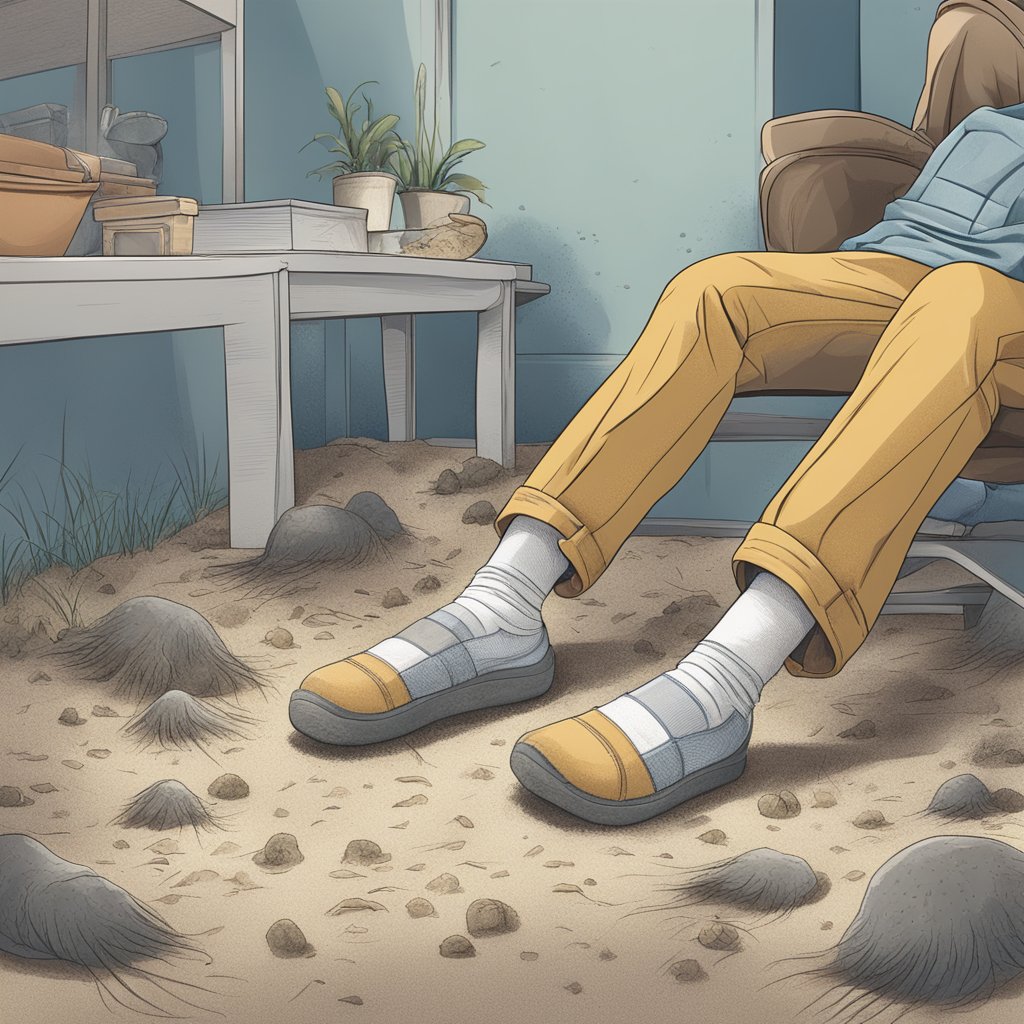Itchy feet can be a common and bothersome condition characterized by an irritating sensation that invites scratching. While often not serious, it can be a symptom of an underlying skin problem or medical condition. A variety of factors may contribute to the itchiness, including dry skin, exposure to irritants, allergic reactions, or infections such as athlete’s foot. Determining the specific cause is essential for finding appropriate treatment and relief.

When it comes to symptoms, they can range from mild to severe and may present with skin changes such as redness, blisters, or cracking. Diagnosis usually involves a physical examination and sometimes skin tests or blood work, based on the suspected cause. Treatments vary and can include over-the-counter creams, prescription medications, or lifestyle changes to avoid triggers. Continuous itching over a prolonged period might lead to complications like infections or skin injury due to scratching, so it’s beneficial to seek medical attention if itchy feet persist.
Key Takeaways
- Itchy feet may signal a skin condition or medical issue requiring treatment.
- Accurate diagnosis is key for effective management and hinges on a thorough symptom assessment.
- Continuous or severe itchy feet necessitate medical evaluation to prevent complications.
Common Causes of Itchy Feet

Itchy feet can arise from a variety of conditions ranging from skin issues to internal health problems. I’ll discuss the most prevalent causes, dividing them into four categories for a comprehensive understanding.
Skin Conditions and Allergic Reactions
Skin conditions, such as eczema and psoriasis, are characterized by dry skin that can cause severe itching. Contact dermatitis, which is an inflammation of the skin resulting from direct contact with irritants or allergens, can lead to a rash and itchiness. The specific allergens might include substances found in soaps, laundry detergents, or even materials used in shoes or socks.
- Eczema: Typically includes dry, itchy skin that can blister or crack.
- Psoriasis: Presents with red, scaly patches that itch.
- Contact Dermatitis: A direct allergic reaction causing a rash often related to footwear materials.
External Factors and Lifestyle
The choice to walk barefoot or the type of socks and shoes worn can contribute to itchy feet. Walking barefoot exposes feet to various irritants, while non-breathable footwear can create a warm, moist environment ideal for fungus growth, leading to athlete’s foot or other fungal infections.
- Irritants: Chemicals, plants, or other substances that come into contact with bare feet.
- Footwear: Poorly fitting shoes or synthetic socks can cause blisters or increase sweating, which may lead to itching.
Infections and Infestations
Fungal infections, such as athlete’s foot (tinea pedis), are common causes of itchy feet. This particular fungal infection thrives in damp conditions and causes peeling, redness, blisters, and severe itch. Additionally, an infestation of scabies caused by mites can also provoke intense itching, especially at night.
- Athlete’s Foot: A common fungal infection presenting with itching, peeling, redness, and sometimes blisters.
- Scabies: A mite infestation leading to intense itching, often severe at night.
Internal Health Issues
Several diseases, including diabetes, liver disease, kidney disease, and thyroid gland diseases, can cause itchy feet. Cholestasis, a condition where bile flow from the liver is reduced, and peripheral neuropathy, which involves nerve damage typically in the hands and feet, can also manifest with itchiness. Pregnant women may experience itchy feet due to pruritus gravidarum.
- Diabetes: Can lead to peripheral neuropathy causing itching.
- Liver Disease/Kidney Disease: May result in build-up of toxins leading to itchiness.
- Thyroid Conditions: Imbalances in thyroid hormones can affect skin health and cause itching.
Symptoms and Diagnosis
When I experience itchy feet, my primary focus is on accurately recognizing the symptoms and seeking a correct diagnosis. I know that pinpointing the exact cause is crucial for effective treatment.
Recognition of Symptoms
Symptoms of itchy feet may include:
- Itchy skin: I often feel a persistent itch that may be accompanied by a sensation of burning or tingling.
- Dry, red, or inflamed skin: My skin might appear dry and flaky or exhibit redness.
- Bumps: Sometimes, small raised bumps are present, that may increase the itching sensation.
Consulting a Doctor
If the itching on my feet persists, I consult a doctor to discuss my symptoms. A doctor can determine if my condition is the result of a skin disorder or if it points to an underlying medical condition. I am candid about any other symptoms I may be experiencing, as this helps the doctor in their assessment.
Medical Tests and Procedures
To reach a diagnosis, my doctor may perform:
- Visual Examination: Inspection of my skin to assess its condition.
- Blood Tests: These can uncover or rule out systemic causes related to liver or kidney function, or signs of infection.
- Biopsy: A sample of my skin cells might be taken to look for any abnormalities that cannot be seen during a visual examination.
The outcome of these tests informs my doctor about the nature of my itchy feet, leading to an accurate diagnosis and an appropriate course of treatment.
Treatment Options
When addressing itchy feet, a multifaceted treatment plan is often the most effective. This includes specific medications, non-medication therapies, and daily skin care routines to manage and prevent symptoms.
Medications
Antihistamines: Over-the-counter (OTC) oral antihistamines like Benadryl (diphenhydramine) can relieve itching by blocking histamine reactions in the body.
Corticosteroids: Topical corticosteroid creams and ointments can reduce inflammation and itchiness. Stronger formulations may require a prescription.
Antifungal Medications: If a fungal infection is causing the itchiness, OTC or prescription antifungal creams, lotions, or powders are effective.
Prescription Medication: Severe cases might need prescription medications, such as gabapentin, which are tailored to individual needs.
Non-Medication Therapies
Oatmeal Bath: An oatmeal bath can soothe itchy skin. Finely ground oatmeal, known as colloidal oatmeal, is added to lukewarm bathwater for relief.
Calamine Lotion: Calamine can provide immediate relief by cooling the skin.
Daily Skin Care and Prevention
-
Moisturizers: Daily application of moisturizers helps maintain skin hydration. Choose a fragrance-free, hypoallergenic moisturizer or lotion to minimize irritation.
-
Mild Soap: Use a mild soap that doesn’t contain irritants or fragrances that can exacerbate itchy skin.
By incorporating these treatments and preventive measures, relief from itchy feet can be managed effectively.
Complications of Chronic Itchy Feet
Chronic itchy feet can lead to a host of issues if not managed properly, particularly through complications such as persistent skin damage and infections.
Effects of Persistent Scratching
When I experience persistent itchy feet, frequently giving in to the urge to scratch can lead to immediate relief. However, consistent scratching can cause several problems:
- Skin barrier breakdown: This allows allergens, irritants, or pathogens to enter more easily, sometimes resulting in swelling and increased redness.
- Thickening of skin: Called lichenification, this makes the skin leathery and more probable to itch.
Long-term Skin Damage
Continuous scratching of itchy feet over time can cause long-term changes to the texture and integrity of the skin:
- Cracking: Chronic pruritus often leads to dryness, which can make my skin cracked and prone to bleeding.
- Scar formation: Repeated damage might result in scarring and even ulcerations that are painful and can be challenging to heal.
Secondary Infections
The compromised skin from chronic itchy feet is an open invitation for infections:
- Bacterial infection: Open sores and cracked skin from scratching are susceptible to bacterial infections, which can be hot to the touch, swollen, and painful.
- Fungal infection: Areas between toes are particularly vulnerable to fungal infections if they become too moist or are repeatedly injured due to itching.
With these complications at stake, it’s imperative to approach the treatment of itchy feet with diligence to prevent further health issues.
Prevention and Lifestyle Management
In this section, I’ll discuss effective strategies to prevent itchy feet through protective measures, personal hygiene, and lifestyle adaptations.
Protective Measures against Infections
Avoid Barefoot Contact: To prevent fungal infections and mites that can cause itching, it’s important to:
- Always wear sandals in communal showers and pool areas.
- Use antifungal sprays or powders when necessary.
Choose Appropriate Footwear:
- Select shoes that allow ventilation, reducing sweat and moisture.
- Ensure shoes fit correctly to avoid pressure sores and blisters, which can lead to infection.
Personal Hygiene and Care
Daily Washing and Drying:
- Clean my feet daily with soap and water, focusing on the toes and soles.
- Dry feet thoroughly, especially between the toes, to prevent a moist environment that fosters fungal growth.
Moisturizing:
- Apply moisturizer to avoid dry skin, which can become itchy, but avoid over-moisturizing as it can lead to maceration.
Adaptation of Habits and Environment
Diet and Exercise:
- I incorporate foods rich in Omega-3 and vitamins to maintain healthy skin.
- Regular exercise promotes circulation in my legs, reducing potential swelling and itchiness.
Stress Management:
- Stress can affect skin health; therefore, I practice relaxation techniques to help manage stress levels.
By integrating these preventive measures and lifestyle management tips into my daily routine, I’m able to reduce the likelihood of developing itchy feet.
Frequently Asked Questions
When addressing itchy feet, I often receive common inquiries about home remedies, potential underlying medical conditions, nighttime itching, differentiating between temporary and chronic conditions, specific causes, and over-the-counter treatments. Below I’ve addressed these concerns based on current understanding and research.
What are common home remedies for itchy feet?
For mild itchy feet, I recommend soaking in a baking soda or oatmeal bath to soothe irritation. Alternatively, applying cold compresses can offer immediate relief. It’s important to keep the skin moisturized, so applying a fragrance-free moisturizer after bathing can also help.
Can itchy feet be a sign of an underlying medical condition?
Yes, itchy feet can sometimes indicate an underlying medical condition such as athlete’s foot, eczema, psoriasis, or even diabetes. If the itchiness is persistent or accompanied by other symptoms, I advise seeing a healthcare provider for an accurate diagnosis.
Why do my feet itch more during the night?
My feet may itch more at night due to increased blood flow and temperature coupled with the absence of daytime distractions. Additionally, the skin’s barrier function changes at night, which might contribute to symptoms of itchiness.
How can I distinguish between a temporary itch and a chronic skin condition on my feet?
If the itch on my feet persists for more than two weeks, frequently recurs, or is accompanied by redness, swelling, or blisters, it could indicate a chronic skin condition. In such cases, I recommend consulting a healthcare provider for assessment.
What are the potential causes of an itch on the sole of the foot?
Itchy soles of the feet can be caused by dry skin, exposure to irritants, fungal infections like athlete’s foot, or plantar xerosis. Sometimes, walking barefoot or wearing footwear without socks can lead to itchy soles due to increased friction and sweat.
Are there any over-the-counter treatments recommended for soothing itchy feet?
Anti-itch creams containing hydrocortisone or antifungal creams can be effective for treating itchy feet, especially if due to athlete’s foot or other mild skin conditions. Always read the label for proper usage and consult with a pharmacist if unsure which product is suitable for my symptoms.